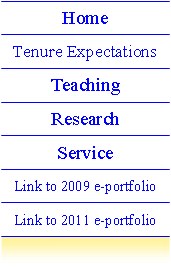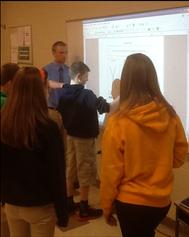








|
Isaac utilizes a SMARTBoard as he teaches a 7th grade math lesson at Jordan Catholic School. Isaac learned strategies for using the SMARTBoard and other technologies in my EDUC 310 course in the winter of ‘12-’13. In the spring of 2013 he was enrolled in my EDUC 384 course where he learned modern mathematics teaching methods appropriate for middle and high school. The partnership I’ve developed with Jordan School enables Isaac and his peers to apply their knowledge from both courses in practice. |
|
Teacher education courses |
|
I have taught several courses in the teacher education program since my arrival at Augustana. Courses I have taught during each of my 5+ years on campus include EDUC 364 (Elementary Math Teaching Methods), EDUC 384 (Secondary Math Teaching Methods), and EDUC 310 (Computers in Education). I have also taught EDUC 422 (Student Teaching Seminar) during two different academic years. My previous e-portfolios have provided extensive evidence related to the quality of these courses. Reviewers are encouraged to return to those web pages in order to get a sense of the time and effort I have put in to developing those courses and, more importantly, to get a sense of student learning outcomes in those courses. Access to these course portfolios is available via the following direct links: I have continued to develop each of these courses over the past two years. As elaborated on pages 6-7 of my 2013 case-making statement, the primary driver of the more recent updates to my courses has been the changing standards and guidelines handed down from external governing authorities. For example, the National Council of Teachers of Mathematics (NCTM) changed its Program Standards between the spring of 2012 and the spring of 2013. This prompted me to make several changes to the EDUC 384 course, changes that are evident when comparing the 2012 and 2013 syllabi. Most notably, the summative Teaching Portfolio assignment was restructured entirely so that the 2013 students could document their competence relative to the latest standards. A glance at a pre-2013 student portfolio and a 2013 student portfolio provides a visual impression of how this cumulative project (which might be viewed as indicative of the structure of the entire course) evolved. The new standards required much more than simply “pouring old wine into new skins” by aligning existing assignments to the new standards. Some of the new standards required new assignments, such as the expectation that all teacher candidates participate in formal professional development work outside of the college classroom. This prompted me to provide my students access to relevant online professional development experiences and assess the learning that they demonstrated through those experiences. One student chronicled the learning fostered by this new course requirement in his Teaching Portfolio. Further evidence of my efforts to keep these courses current and aligned to the latest standards is available in syllabi posted in the side bar. For instance, the Illinois State Board of Education (ISBE) updated it Illinois Professional Teaching Standards recently. This prompted course changes between the 2012 and 2013 versions of the EDUC 364 syllabus and also between the 2011 and 2013 EDUC 422 syllabus. ISBE’s rule that, effective 2015, all teacher candidates must successfully pass the edTPA assessment in order to earn licenses has prompted proactive preparation on the part of myself and my colleagues. In my role as edTPA coordinator, I introduced the edTPA as a required component in the EDUC 422 course in the fall of 2011. As the high stakes year of 2015 approaches, I have also decided to begin incorporating aspects of this assessment into my teaching methods courses. This is yet another major, “modernizing” change between the 2012 and 2013 versions of EDUC 364 (and will be a change for EDUC 384 in 2014). Staying current in my courses (or even one step ahead of the bureaucracies) is not the most glamorous aspect of my work, but it is very important. It represents one important way that I, as a teacher educator, can ensure that Augustana graduates are ready for the teaching profession as it currently stands. It is satisfying to know that recent graduates have expressed gratitude for the modern relevance and helpfulness of the education they have received in my courses. |


|
Mike Egan Assistant Professor Education Department |
|
Course Artifacts
Syllabi
Student Ratings of Instruction: Quantitative Summaries EDUC 364 Fall 2011# EDUC 364 Fall 2012 EDUC 384 Spring 2012 EDUC 384 Spring 2013 EDUC 310 Winter ‘11-’12 EDUC 310 Winter ‘12-’13
Student Ratings of Instruction: Complete Forms
*Note: EDUC 422 is a 1-credit course and hence does not include formal Student Ratings of Instruction
# The Fall 2011 EDUC 364 SRIs were not available in time to be included with my 2011 pre-tenure review materials. Therefore, they are being included here. The Fall 2011 syllabus was included with that set of materials, so it is not provided here. |